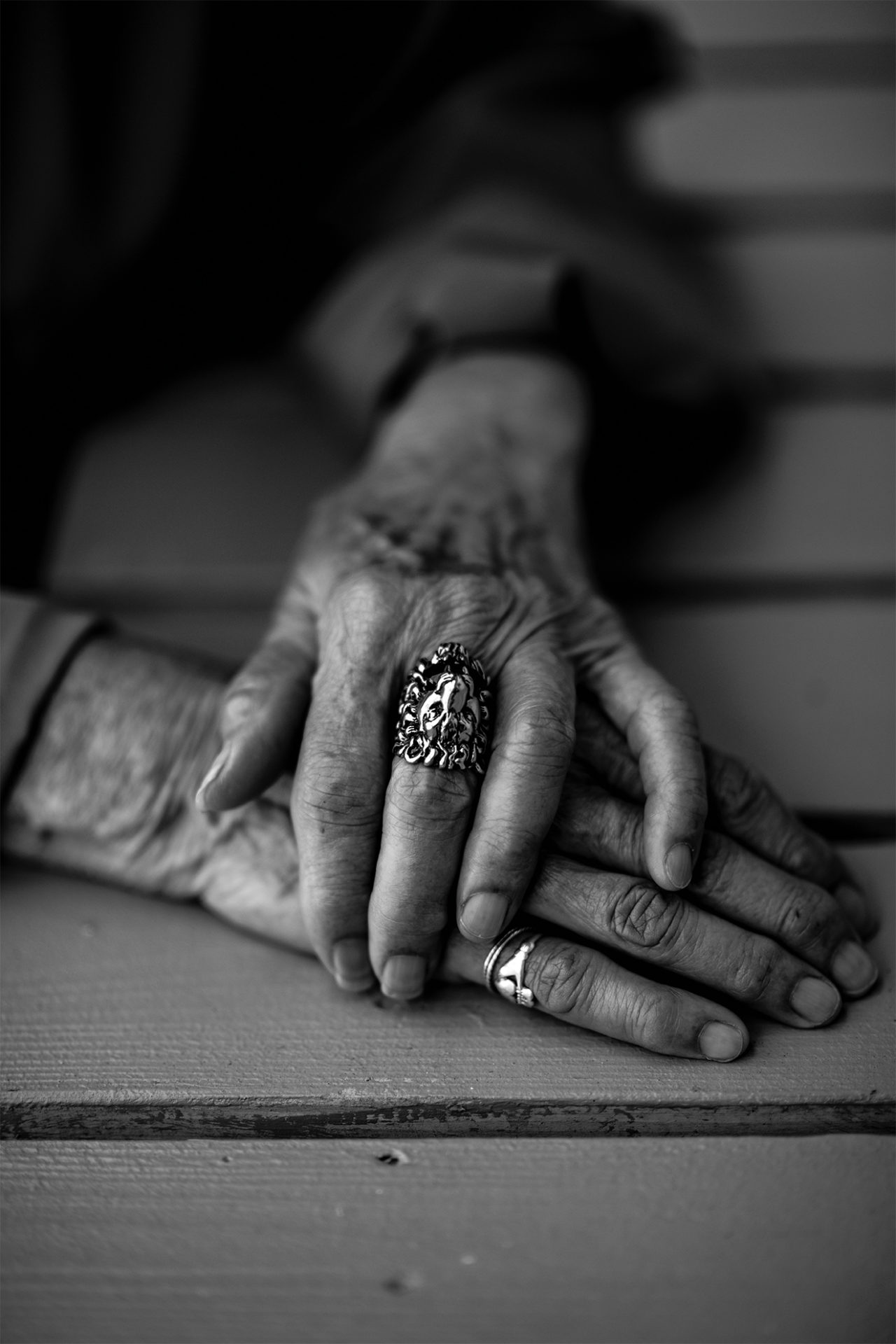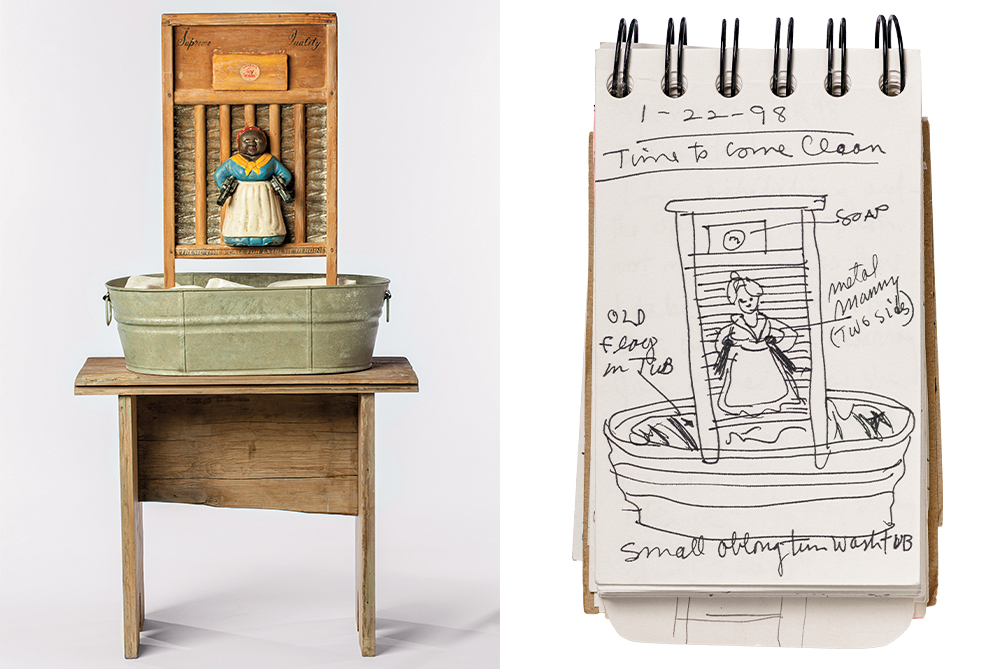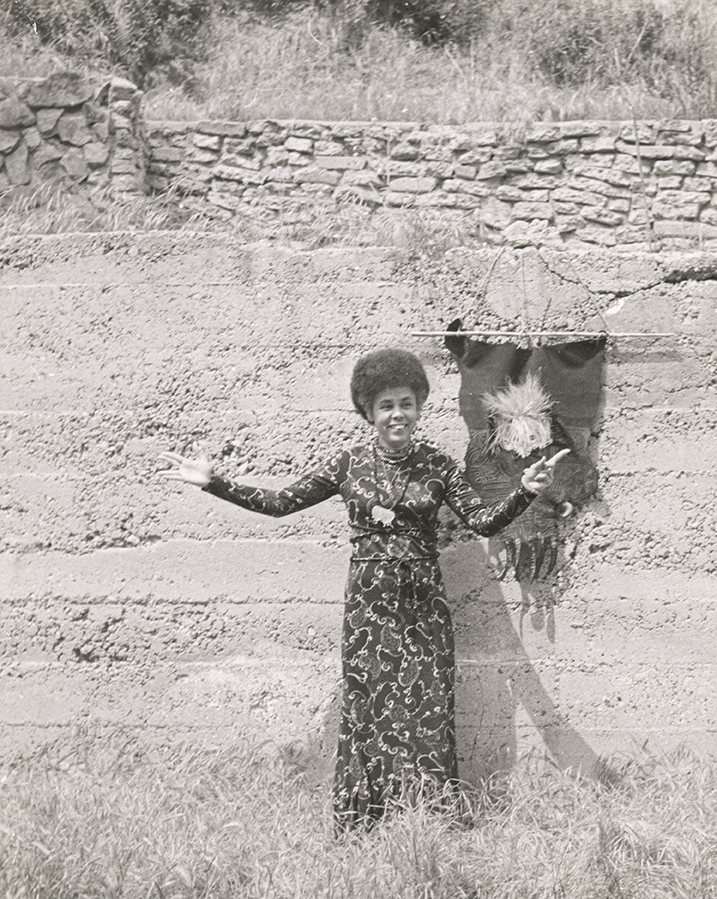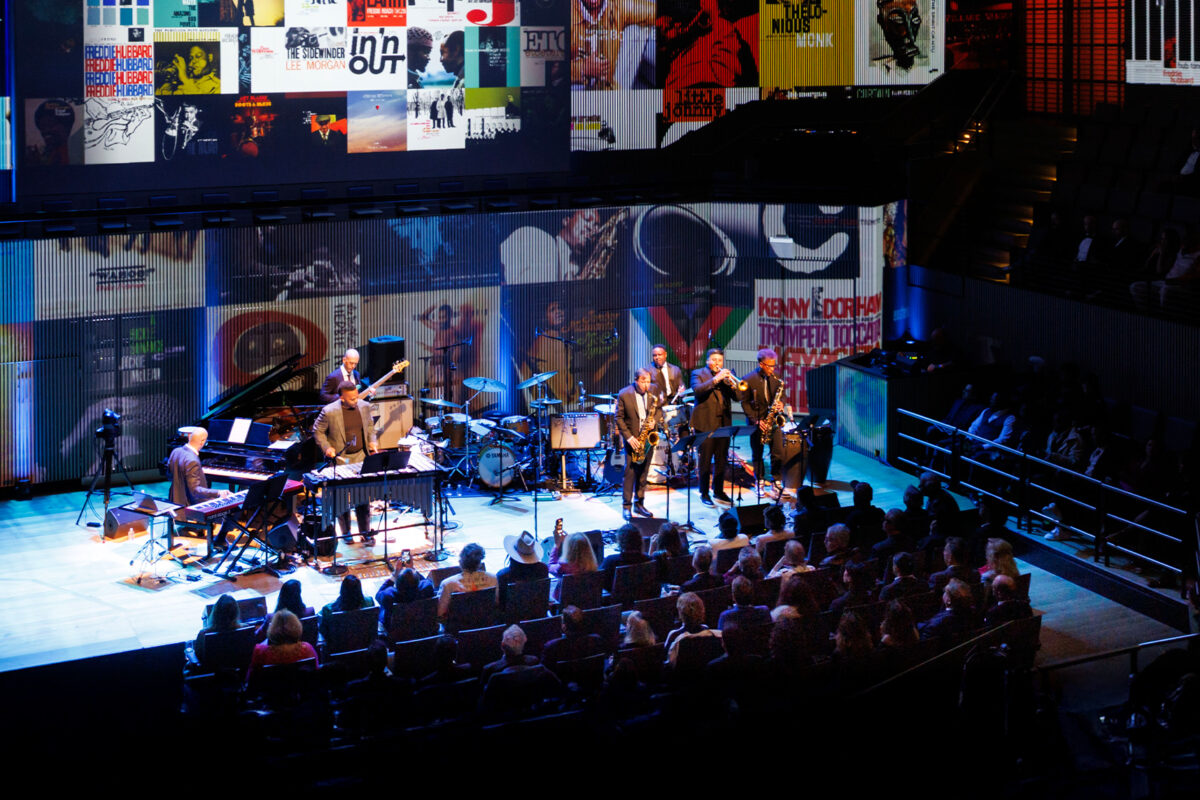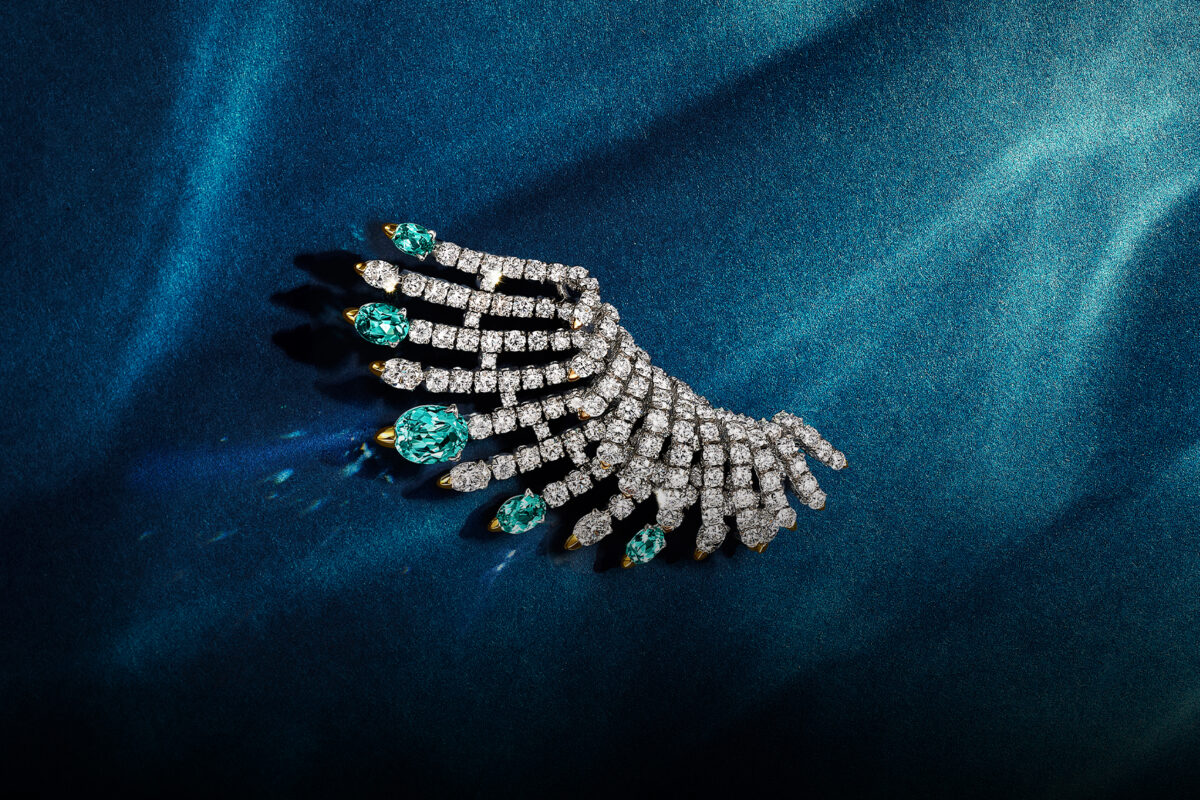The assemblage artist has played a pivotal role in the foremost cultural movements of the last century. And at 93, she shows no signs of slowing down
Words by MATT STROMBERG
Photography by AMANDA DEMME
Creative and Fashion Direction by ALISON EDMOND
In the sloping hills of Laurel Canyon, Betye Saar’s studio is filled with raw materials. Instead of paint or clay, however, these are the everyday objects the assemblage artist has acquired over the past 50 years at flea markets and garage sales, all organized neatly by type: clocks, birdcages, starfish, globes, wooden chairs and colored glass bottles. Tacked to a wall is a large diagram of the British slave ship Brookes, in which dozens of black silhouettes are crammed tightly together. It is a haunting image underscoring the brutality of slavery that Saar has included in several works. One table holds only red items, including painted wooden slices of watermelon, a derogatory “mammy” figure, and an afro pick, above which a framed Barack Obama “Hope” poster and a red African mask hang on the wall.
“As a kid, I’d always been a collector like most kids are — bits of broken glass, whatever I would find,” she says, sitting on the garden terrace full of succulents, herbs and vegetables that Saar tends herself, separating her modest living quarters from her studio. A blue mosaic grotto composed of bits of broken pottery, seashells and marbles — an ongoing collaboration between Saar and her middle daughter, Alison, also an artist — welcomes visitors outside the entrance to her home.
Saar’s method is to weave her collected objects into hybrid sculptures that highlight “the everyday magic of ordinary things,” as she puts it, her voice still full of wonder at the idea. “You know my series on washboards? What can be more ordinary than a washboard? Or a chair? Or table or cupboard? I try to be the magician and to transform it into something else that tells another story.” Throughout our conversation, Saar maintains such an impressive recall on her history, bouncing nimbly back and forth between her childhood, early career and her current flurry of activity that you quickly forget she is in fact 93.
More than an impassioned storyteller, Saar is best known as a trailblazer who was at the center of both the feminist and black arts movements at a time when being an African-American woman artist was itself radical. Her seminal 1972 work The Liberation of Aunt Jemima was a defining statement of the era, one that appropriated and dismantled a commonplace racist and misogynist trope (that of Aunt Jemima, a symbol of black subservience to a white ruling class) with humor and wit. Saar had been invited to create a work for a show at a black cultural center in Berkeley called the Rainbow Sign. “I didn’t have a hero, but I had a ‘she-ro’ and that was Aunt Jemima,” she says. “So I made The Liberation of Aunt Jemima, which became my icon.” Inside a box no larger than a sheet of paper, Saar placed a figurine of Aunt Jemima with bulging eyes, large red lips, a broom in one hand and a rifle in the other. Superimposed on the figure was a caricatured image of Jemima holding a white child, on top of which Saar laid a cutout of a Black Power fist.
“I’m not upset if I’m accepted or not, I’m not responsible for educating everybody”
Betye Saar
“Instead of a derogatory image that was a servant, she rebelled against that,” Saar explains. “This was also the beginning of the feminist movement and the beginning of the civil rights movement, so she was just a perfect one to give civil rights to. She was liberated by making her a warrior, and that started me on a whole other trend of doing political pieces, of taking derogatory images and transforming them into warriors, to people of respect.”
Four years earlier, Saar had been profoundly affected by the assassination of Dr. Martin Luther King Jr., prompting a deepening engagement with black culture. The sentiment was shared by other African-American assemblage artists in Los Angeles, like Noah Purifoy and John Outterbridge, who had been creating works from the charred rubble of the Watts uprising that reflected the struggle and resilience of the black community at the time.
This fall, Saar mounts two significant solo shows on either coast. In September, the Los Angeles County Museum of Art opened “Betye Saar: Call and Response,” a career-spanning exhibition pairing drawings from her sketchbooks with corresponding finished artworks (on view through April 5, 2020). This October, “Betye Saar: The Legends of Black Girl’s Window” opens at New York’s Museum of Modern Art (on view through Jan. 4, 2020). Centered on Saar’s 1969 assemblage piece Black Girl’s Window, the show features 42 works on paper recently acquired by the museum that showcase her innovative printmaking practice. And in November, Saar will be an honoree at LACMA’s annual Art+Film Gala alongside Mexican Oscar-winning director Alfonso Cuarón. This is one of L.A.’s highest cultural honors: Past honorees include Ed Ruscha, David Hockney, Martin Scorsese, Quentin Tarantino and Barbara Kruger.
In addition to the major museum shows, Saar’s archives were acquired by the Getty Research Institute last year, ensuring that her papers, journals and collections of ephemera will be accessible for future generations. Her Culver City-based gallery, Roberts Projects, has also been working on her catalogue raisonne for the past five years, compiling and digitizing images from a lifetime of work.
Although Saar has been well-respected throughout her career, major institutional attention has been elusive. “She was not unknown, but underknown and undervalued,” explains Carol Eliel, curator of LACMA’s “Call and Response.” Given the recent groundswell of attention on her life and work, one wonders: What took so long? “I do feel that being a black woman, coming of age in the ’60s in California, she had three strikes against her,” Eliel says.
Saar is not one to dwell in the past, however — she’s too busy creating new work every day and looking ahead. “I don’t know, and I don’t care, as long as it’s happening,” she says. “My focus is making the art and just living. I’m not upset if I’m accepted or not accepted or whatever because I’m not responsible for educating everybody. I think it’s good art, and they finally opened their eyes and saw that.”
Saar was born in 1926 in L.A. and moved in with her great-aunt Hattie in Pasadena with her mother and siblings after the untimely death of her father in 1931. The family would periodically visit her paternal grandmother, who lived in Watts, and it was on one of these trips that she had an encounter that would have a profound effect on her. “I saw this man doing these strange things over there,” she recalls. “Simon Rodia was building Watts Towers, but I didn’t know what they were.” Over the course of 30-plus years, Rodia, an Italian immigrant who worked as a construction worker by day, created the whimsical series of cone-shaped towers using only his bare hands and basic tools. He covered them in a colorful mosaic of found objects and debris, including tiles, broken pottery and sea shells.
Rodia’s can-do spirit echoed Saar’s own upbringing. “My mother was a creative person: She knew how to sew, so my sister and I learned how to sew,” she recalls. “This was during the Depression, so we made things for gifts, because you couldn’t buy anything, we didn’t have money. … We just knew how to do things with our hands, and that has stuck with me.” Saar studied design at UCLA, graduating in 1949 intent on becoming an interior designer. “Being from a minority family, I never thought about being an artist,” she told the Los Angeles Times in 2016. “But I could tell people how to buy curtains.” In 1952, she married ceramicist Richard Saar, and the couple had three daughters: Alison and Lezley, accomplished artists in their own right, and Tracye, a writer. When Richard left his ceramics career to become a technical illustrator, the family relocated to Laurel Canyon to be closer to his work. Though she and Richard divorced in 1968, the house they moved into in 1962 is where Saar still lives today. At the time, the landscape was quite desolate owing to a fire a few years earlier. “The houses from my house down to Laurel Canyon had all burnt down,” she says. “But this house had lived through the fire. So I figured, ‘This must be a charmed house.’ It still is.”
“Being from a minority family, I never thought about being an artist. But I could tell people how to buy curtains”
Betye Saar
Laurel Canyon was a counterculture mecca of the period, and the Saars counted several popular rock and folk musicians among their neighbors, including Frank Zappa and Mama Cass. “It was hippie-ville. … Love-ins, so to speak, were the thing for entertainment,” she says with a mischievous grin.
Following her time at UCLA, Saar began graduate studies at Cal State Long Beach, working toward a career in teaching design. One day, however, she walked past a printmaking room and was drawn in by the medium. “It just seemed really fascinating, so I started taking print classes,” she recalls. “The whole procedure of getting a plate and making a pattern on the plate and inking the plate, it was kind of a ritual that appealed to me.” She shifted her studies, got her own press and began exhibiting at Koslow Gallery in Encino in 1964 and, later, at Ankrum Gallery in L.A. in 1966.
The next major milestone in her artistic evolution came in 1967, when she attended a Joseph Cornell exhibition at the Pasadena Art Museum (now the Norton Simon Museum). She was smitten with Cornell’s boxes and his idiosyncratic, yet poetic juxtapositions of items. “This was the first time I’d ever seen an assemblage,” she says. “And I said, ‘I want to make things like that.’ So from that time on I started collecting boxes and curious objects.”
A trip to Chicago’s Field Museum in 1970 proved to be another turning point. The museum’s extensive collection of African art expanded the wealth of aesthetic traditions she could pull from. These came to the fore in a 1973 solo show at Cal State L.A., which featured objects that suggested shamanic or ritualistic functions, including paintings on cowhide, drawing on sources from across the African diaspora, including Haiti and the U.S. A replica of the exhibition was recently featured in “Soul of a Nation: Art in the Age of Black Power 1963-1983” at L.A.’s The Broad museum, a wide-ranging survey of politically charged black art of the period. “It was weird stuff, but now, many decades later, that show is kind of the foundation of my work,” Saar told Art In America earlier this year.
In the ensuing decades, Saar has straddled two poles: the political and the metaphysical, often combining them in the same work. (“Even in the metaphysical ones, I maybe have a slice of watermelon, or a mammy figure or Uncle Tom figure that refers back to [the political].”) Alongside her more intimate assemblages, Saar has expanded her practice to include large installations, the latest of which will be featured in “Call and Response.” Titled Woke Up This Morning, the Blues Was in My Bed, it consists of a number of blue bottles attached to a folding army cot, which sits on a bed of coal with a blue neon wave. Eliel explains the origin of the work goes back to sketches from 2001, however Saar waited to construct the work until she had a proper place to show it. Touching on themes of spirituality, gender and race, the work seems more relevant than ever, but Saar insists she’s not taking aim at our current political and cultural morass specifically. “No! I don’t want to use my creative energy on that!” she exclaims. “My creative energy goes to what I would like for it to be, the mystical things, the positive things of one world, one people, because that’s the bottom line.”
Hair and Makeup by DEE DALY at Opus Beauty using Oribe and Chanel Les Beiges
This story originally appeared in the October 2019 issue of C Magazine.
Discover more CULTURE news.

